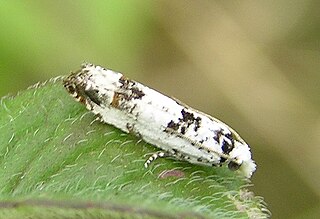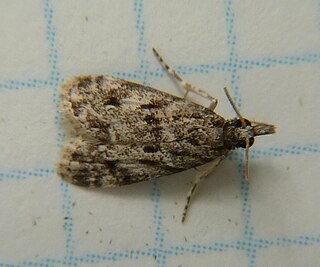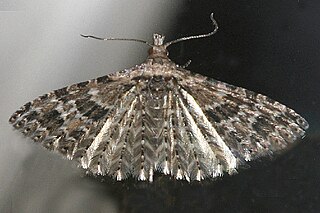
Crambidae comprises the grass moth family of lepidopterans. They are variable in appearance, with the nominal subfamily Crambinae taking up closely folded postures on grass stems where they are inconspicuous, while other subfamilies include brightly coloured and patterned insects that rest in wing-spread attitudes.

The flannel moths or crinkled flannel moths are a family of insects. They occur in North America and the New World tropics.

Pyrgus is a genus in the skippers butterfly family, Hesperiidae, known as the grizzled skippers. The name "checkered" or "chequered skipper" may also be applied to some species, but also refers to species in the genera Burnsius and Carterocephalus. They occur in the Holarctic with an additional group of species extending to the Neotropic.

Doidae is a family of Lepidoptera first described by Julian P. Donahue and John W. Brown in 1987. Species in Doidae had previously been placed in the Arctiidae, Lymantriidae and the Dioptidae.

Schinia, commonly called flower moths, is a large genus of moths belonging to the family Noctuidae. The genus has a Holarctic distribution with the vast majority of species being found in North America, many with a very restricted range and larval food plant.

The Noctuinae are a subfamily of the family Noctuidae, and is composed of moths. The larvae of many species feed on roots or stems of various grasses. Some are generalist feeders which makes them potential pests.

Eucosma is a very large genus of moths belonging to the family Tortricidae. Some taxonomies place a number of species in the genus Eucopina. The genus has a Holarctic and Indomalayan distribution. Even in well-studied Europe and North America, new species are still regularly discovered. There are at least 670 described species in Eucosma worldwide.

The Thyatirinae, or false owlet moths, are a subfamily of the moth family Drepanidae with about 200 species described. Until recently, most classifications treated this group as a separate family called Thyatiridae.

Chlosyne gorgone, the gorgone checkerspot, is a species of Nymphalinae butterfly that occurs in North America.

Achyra rantalis, the garden webworm, is a moth of the family Crambidae described by Achille Guenée in 1854. It is found in North America, where it has been recorded from Maine to southern Quebec and Ontario, south to Florida and Mexico. It has also been recorded from Iowa, Colorado, California and the West Indies. Its habitat consists of fields and gardens.

Apogeshna is a genus of moths of the family Crambidae.

Lasaia sula, the blue metalmark, is a species of butterfly in the family Riodinidae that is native to North America. It ranges from the Lower Rio Grande Valley of Texas in the United States south to Honduras and inhabits subtropical forests, forest edges, and agricultural areas.

Pyrgus scriptura, the small checkered skipper, is a species of skipper. It is found from the Texas to Montana, southeastern Alberta, and southwestern Saskatchewan.

Scoparia basalis, the many-spotted scoparia moth, is a moth of the family Crambidae. It is found in North America, including Arkansas, British Columbia, Georgia, Maine, Massachusetts, New Jersey, Oklahoma, Tennessee, Virginia and Washington.

Pyrausta acrionalis, the mint-loving pyrausta moth, is a moth of the family Crambidae. It is found in eastern North America, including Alabama, Georgia, Massachusetts, Mississippi, New Hampshire, New York, Ontario, Tennessee, West Virginia and Wisconsin.
BugGuide is a website and online community of naturalists, both amateur and professional, who share observations of arthropods such as insects, spiders, and other related creatures. The website consists of informational guide pages and many thousands of photographs of arthropods from the United States and Canada which are used for identification and research. The non-commercial site is hosted by the Iowa State University Department of Entomology. BugGuide was conceived by photographer Troy Bartlett in 2003 and since 2006 has been maintained by John VanDyk, an adjunct assistant professor of entomology and a senior systems analyst at Iowa State University. The website has been recognized for helping change the public perception of insects.

Alucita montana, the Montana six-plume moth, is a moth of the family Alucitidae. It was described by William Barnes and Arthur Ward Lindsey in 1921. It is found in North America from south-western Quebec and Vermont, west to British Columbia and south to Arizona, California and Texas.

Chloropteryx tepperaria, the angle-winged emerald moth, is a moth of the family Geometridae. The species was first described by George Duryea Hulst in 1886 and it is found in the southeastern United States.

Tornos scolopacinaria, the dimorphic gray, is a species of geometrid moth in the family Geometridae. It is found in North America.

Steniini is a tribe of the species-rich subfamily Spilomelinae in the pyraloid moth family Crambidae. The tribe was erected by Achille Guenée in 1854.



















